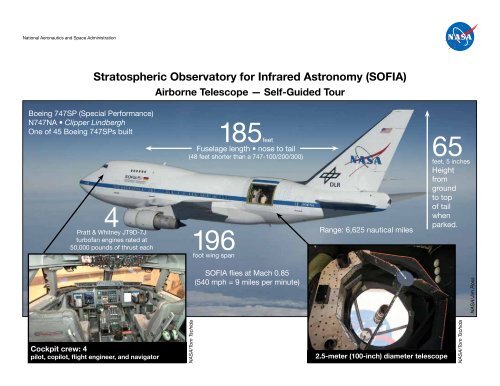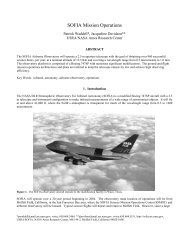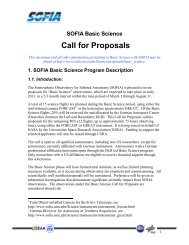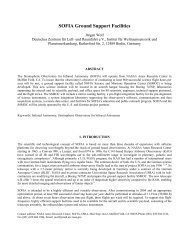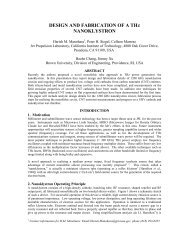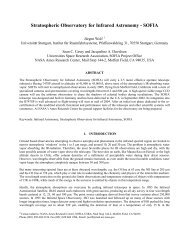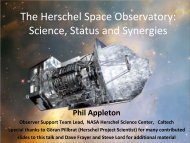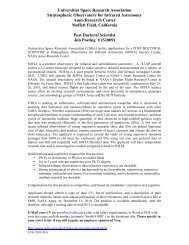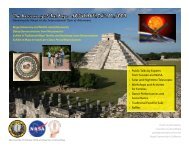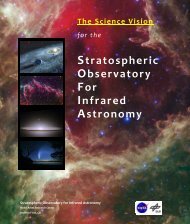Stratospheric Observatory for Infrared Astronomy ... - SOFIA - USRA
Stratospheric Observatory for Infrared Astronomy ... - SOFIA - USRA
Stratospheric Observatory for Infrared Astronomy ... - SOFIA - USRA
You also want an ePaper? Increase the reach of your titles
YUMPU automatically turns print PDFs into web optimized ePapers that Google loves.
National Aeronautics and Space Administration<br />
<strong>Stratospheric</strong> <strong>Observatory</strong> <strong>for</strong> <strong>Infrared</strong> <strong>Astronomy</strong> (<strong>SOFIA</strong>)<br />
Airborne Telescope — Self-Guided Tour<br />
Boeing 747SP (Special Per<strong>for</strong>mance)<br />
N747NA • Clipper Lindbergh<br />
One of 45 Boeing 747SPs built<br />
4<br />
Pratt & Whitney JT9D-7J<br />
turbofan engines rated at<br />
50,000 pounds of thrust each<br />
185feet<br />
Fuselage length • nose to tail<br />
(48 feet shorter than a 747-100/200/300)<br />
196<br />
foot wing span<br />
Range: 6,625 nautical miles<br />
65<br />
feet, 5 inches<br />
Height<br />
from<br />
ground<br />
to top<br />
of tail<br />
when<br />
parked.<br />
<strong>SOFIA</strong> flies at Mach 0.85<br />
(540 mph = 9 miles per minute)<br />
NASA/Jim Ross<br />
Cockpit crew: 4<br />
pilot, copilot, flight engineer, and navigator<br />
NASA/Tom Tschida<br />
2.5-meter (100-inch) diameter telescope<br />
NASA/Tom Tschida
Telescope Team seats<br />
German <strong>SOFIA</strong> Institute (DSI)<br />
engineers occupy these seats to<br />
test and monitor the telescope’s<br />
per<strong>for</strong>mance.<br />
Science Conference Table<br />
Guest scientists use this area in flight<br />
to confer and communicate with the<br />
airborne science operations staff, the<br />
Science Flight Planner, and the Mission<br />
Director to discuss the ongoing<br />
observations and view real-time data.<br />
Mission Controls and<br />
Communication System<br />
(MCCS) Racks<br />
This is the backbone of the observatory<br />
that distributes power,<br />
collects data, and enables various<br />
on-board software suites and<br />
workstations to talk to each other.<br />
Airborne <strong>Astronomy</strong> Ambassadors<br />
(AAA) Console<br />
Educators who fly as part of the AAA Program<br />
observe science operations from a set of<br />
monitors located here. Since 2011, over<br />
30 educators have flown on <strong>SOFIA</strong> and<br />
are taking their flight experiences into their<br />
classroom and to their communities to help<br />
promote interest in science, technology, engineering,<br />
and math.<br />
<strong>SOFIA</strong> Self-Guided Tour • <strong>Observatory</strong> Interior<br />
Telescope Operators’ station<br />
Mission Director (left seat)<br />
Science Flight Planner (right seat)<br />
The Mission Director (MD) has overall<br />
control of science operations during flight<br />
and works closely with the Science Flight<br />
Planner (SFP) to ensure that observations<br />
are on schedule and all systems function<br />
properly. The SFP and MD together<br />
can change observation targets and flight<br />
routes if necessary.<br />
FLITECAM<br />
HIPO<br />
<strong>SOFIA</strong> is a joint program between NASA and the German Aerospace Center (DLR).<br />
www.nasa.gov • www.dlr.de/en/sofia • www.sofia.usra.edu • www.dsi.uni-stuttgart.de<br />
FLITECAM Team Workstation<br />
The First Light <strong>Infrared</strong> Test Experiment<br />
CAMera (FLITECAM) collects infrared<br />
light with wavelengths between 1 and<br />
5.5 microns. FLITECAM is also used to<br />
help measure <strong>SOFIA</strong>’s image quality,<br />
telescope stability, and infrared background<br />
emission.<br />
Instrument Mounting<br />
Flange<br />
The High-speed Imaging<br />
Photometer <strong>for</strong> Occultations<br />
(HIPO) sits closest to the<br />
telescope when co-mounted<br />
with FLITECAM, as shown<br />
here. HIPO collects ultraviolet,<br />
visible, and infrared light with<br />
wavelengths between 0.3 and<br />
1.1 microns, and is <strong>SOFIA</strong>’s<br />
main image quality test instrument.<br />
In June 2011, HIPO<br />
was flown to analyze Pluto’s<br />
atmosphere when the dwarf<br />
planet passed in front of a<br />
distant star.<br />
<strong>SOFIA</strong>’s 2.5 meter (100-inch)<br />
Bent Cassegrain/Nasmyth<br />
Telescope<br />
The heart of <strong>SOFIA</strong> was built in<br />
Germany by MAN Technologie AG and<br />
Kayser-Threde GmbH. The telescope<br />
collects radiation with wavelengths<br />
between 0.3 and 1600 microns. The<br />
telescope has a full altitude range of<br />
+20 to +60 degrees above the horizon.<br />
All photos this page: NASA/<strong>SOFIA</strong>/N. Veronico


